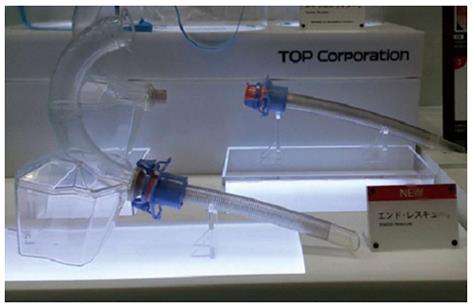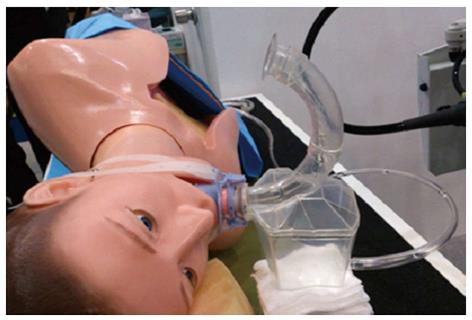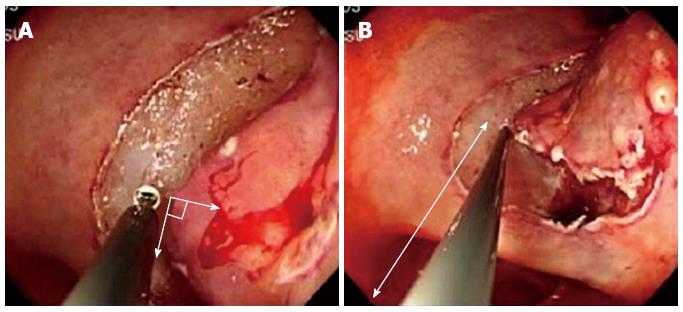Published online Feb 14, 2014. doi: 10.3748/wjg.v20.i6.1623
Revised: October 12, 2013
Accepted: November 3, 2013
Published online: February 14, 2014
Processing time: 160 Days and 17.7 Hours
Previously, we reported the efficacy of a newly developed inverted overtube in shortening the hemostatic time and obtaining a clear endoscopic view in emergency endoscopic hemostasis. This device also helped us to perform gastric endoscopic submucosal dissection (ESD) more safely by changing the direction of gravity in the right lateral position. To perform a safe ESD, it is important to make an appropriate angle and distance between the electric knife and the gastric mucosa. In this position, the distance to gastric mucosa is reduced, and the angle of the electric knife changes from vertical to somewhat oblique, facilitating safer cutting.
Core tip: In gastric endoscopic submucosal dissection (ESD), the patient’s position must be altered according to the direction of gravity to use an appropriate angle and distance between electric knife and mucosa for safety as well as colorectal ESD.
- Citation: Mori H, Rafiq K, Kobara H, Nishiyama N, Fujihara S, Yachida T, Ayagi M, Tani J, Miyoshi H, Masaki T. An effective and safe gastric endoscopic submucosal dissection in the right lateral position using an inverted overtube. World J Gastroenterol 2014; 20(6): 1623-1625
- URL: https://www.wjgnet.com/1007-9327/full/v20/i6/1623.htm
- DOI: https://dx.doi.org/10.3748/wjg.v20.i6.1623
As endoscopic submucosal dissection (ESD) for early gastric cancer was developed to resect en bloc specimens of larger lesions safely, which is a determinant factor for histological assessment of resected specimens[1-3]. The rate of complications such as perforations and bleedings is still high[4-6]. One of the factors of difficulty level depends on the location, which may be located in the esophagogastric junction, fornix, or lower body of the lesser curvature, among other locations. In these regions, it is very difficult for us to make appropriate distance and appropriate angle between gastric mucosa and electric knife[7-9]. On the other hand, we perform colonoscopy both in the left lateral position and right lateral position by rotating patients to take advantage of gravity. We investigated the efficacy and safety of gastric ESD by rotating patient’s position from conventional left lateral position to right lateral position using inverted overtube.
The outer appearance of the inverted overtube is shown in Figure 1 (TOP co., Tokyo, Japan), and the simulated model of using the inverted overtube is shown in Figure 2. The inverted overtube was approved by the Institutional Ethics Committee of Kagawa University Hospital, Kagawa, Japan. Additionally, the inverted overtube was approved by the Japanese Pharmaceutical Law.
Sixty-three-year-old and seventy-two-year-old men underwent ESD due to early gastric cancer located in the lower body of the lesser curvature. In both patients, we began to perform ESD in the left lateral position. After marking the resection line, we realized that the electric knife was located vertically relative to the gastric mucosa in the conventional left lateral position (Figure 3A). The resected line was located farther from the endoscope and was thus difficult to approach (Figure 3B).
We rotated the patients’ positions to the right lateral position and placed the inverted overtube into their mouths (Figure 4A). As the direction of gravity to the stomach changed, the angle between the electric knife and the gastric mucosa changed to approximately 20 degrees, facilitating safe cutting (Figure 4B).
In order to perform a safe ESD, it is important to use an appropriate angle and distance between the electric knife and the gastric mucosa[7,8]. The level difficulty depends on the location, which may be located in the esophagogastric junction, fornix, or lower body of the lesser curvature, among other locations[9]. In the right lateral position, the distance between the electric knife and the gastric mucosa is reduced, and the angle of the electric knife changes from vertical to somewhat oblique, facilitating safer cutting. In gastric ESD, the patient’s position must be altered according to the direction of gravity, as in done colonoscopies[10].
Furthermore, most endoscopists perform endoscopic treatment procedures with the patient lying in the left lateral position. Performing gastric ESD from the opposite side, with the patient lying in the right lateral position is very difficult. Therefore, the use of the inverted overtube is the best method to help endoscopists perform gastric ESD with less stress because they are in their conventional standing position relative to patients rotated to the right lateral position. This new ESD technique is the most effective way to make appropriate distance and appropriate angle between gastric mucosa and electric knife by gravity. The present technique dramatically changed the conventional concept of endoscopic procedure and enabled the endoscopist to perform the endoscopic treatment procedures from the conventional standing position while freely and easily changing the patient’s position according to their needs of the direction of gravity.
We would like to thank Dr. Makoto Oryu for technical and editorial assistance.
P- Reviewers: Fan ZN, Kakushima N, Min BH, Sakamoto T, Wang BM S- Editor: Gou SX L- Editor: A E- Editor: Wu HL
| 1. | Yamamoto H, Kawata H, Sunada K, Sasaki A, Nakazawa K, Miyata T, Sekine Y, Yano T, Satoh K, Ido K. Successful en-bloc resection of large superficial tumors in the stomach and colon using sodium hyaluronate and small-caliber-tip transparent hood. Endoscopy. 2003;35:690-694. [PubMed] |
| 2. | Oyama T, Tomori A, Hotta K, Morita S, Kominato K, Tanaka M, Miyata Y. Endoscopic submucosal dissection of early esophageal cancer. Clin Gastroenterol Hepatol. 2005;3:S67-S70. [RCA] [PubMed] [DOI] [Full Text] [Cited by in Crossref: 438] [Cited by in RCA: 459] [Article Influence: 23.0] [Reference Citation Analysis (0)] |
| 3. | Ono H, Kondo H, Gotoda T, Shirao K, Yamaguchi H, Saito D, Hosokawa K, Shimoda T, Yoshida S. Endoscopic mucosal resection for treatment of early gastric cancer. Gut. 2001;48:225-229. [PubMed] |
| 4. | Takizawa K, Oda I, Gotoda T, Yokoi C, Matsuda T, Saito Y, Saito D, Ono H. Routine coagulation of visible vessels may prevent delayed bleeding after endoscopic submucosal dissection--an analysis of risk factors. Endoscopy. 2008;40:179-183. [RCA] [PubMed] [DOI] [Full Text] [Cited by in Crossref: 235] [Cited by in RCA: 271] [Article Influence: 15.9] [Reference Citation Analysis (0)] |
| 5. | Oda I, Gotoda T, Hamanaka H. Endoscopic submucosal dissection of early gastric cancer: technical feasibility, operation time, and complications from a large consecutive series. Dig Endosc. 2005;17:54-58. [RCA] [DOI] [Full Text] [Cited by in Crossref: 336] [Cited by in RCA: 333] [Article Influence: 16.7] [Reference Citation Analysis (2)] |
| 6. | Gotoda T. A large endoscopic resection by endoscopic submucosal dissection procedure for early gastric cancer. Clin Gastroenterol Hepatol. 2005;3:S71-S73. [RCA] [PubMed] [DOI] [Full Text] [Cited by in Crossref: 132] [Cited by in RCA: 141] [Article Influence: 7.1] [Reference Citation Analysis (0)] |
| 7. | Lu ZS, Yang YS, Feng D, Wang SF, Yuan J, Huang J, Wang XD, Meng JY, Du H, Wang HB. Predictive factors of endoscopic submucosal dissection procedure time for gastric superficial neoplasia. World J Gastroenterol. 2012;18:7009-7014. [RCA] [PubMed] [DOI] [Full Text] [Full Text (PDF)] [Cited by in CrossRef: 10] [Cited by in RCA: 12] [Article Influence: 0.9] [Reference Citation Analysis (0)] |
| 8. | Kim M, Jeon SW, Cho KB, Park KS, Kim ES, Park CK, Seo HE, Chung YJ, Kwon JG, Jung JT. Predictive risk factors of perforation in gastric endoscopic submucosal dissection for early gastric cancer: a large, multicenter study. Surg Endosc. 2013;27:1372-1378. [RCA] [PubMed] [DOI] [Full Text] [Cited by in Crossref: 30] [Cited by in RCA: 35] [Article Influence: 2.7] [Reference Citation Analysis (0)] |
| 9. | Imagawa A, Okada H, Kawahara Y, Takenaka R, Kato J, Kawamoto H, Fujiki S, Takata R, Yoshino T, Shiratori Y. Endoscopic submucosal dissection for early gastric cancer: results and degrees of technical difficulty as well as success. Endoscopy. 2006;38:987-990. [RCA] [PubMed] [DOI] [Full Text] [Cited by in Crossref: 218] [Cited by in RCA: 234] [Article Influence: 12.3] [Reference Citation Analysis (0)] |
| 10. | Mori H, Kobara H, Fujihara S, Nishiyama N, Oryu M, Rafiq K, Masaki T. Accurate hemostasis with a new endoscopic overtube for emergency endoscopy. World J Gastroenterol. 2013;19:2723-2726. [RCA] [PubMed] [DOI] [Full Text] [Full Text (PDF)] [Cited by in CrossRef: 3] [Cited by in RCA: 5] [Article Influence: 0.4] [Reference Citation Analysis (1)] |












